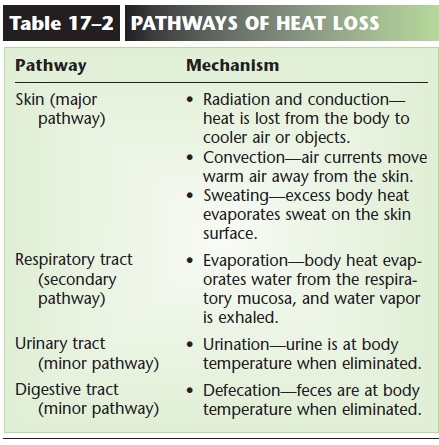Chapter: Essentials of Anatomy and Physiology: Body Temperature and Metabolism
Heat Loss - Body Temperature
HEAT LOSS
The pathways of heat loss from the body are the skin, the respiratory tract, and, to a lesser extent, the uri-nary and digestive tracts.
Heat Loss through the Skin
Because the skin covers the body, most body heat is lost from the skin to the environment. When the envi-ronment is cooler than body temperature (as it usually is), heat loss is unavoidable. The amount of heat that is lost is determined by blood flow through the skin and by the activity of sweat glands.
Blood flow through the skin influences the amount of heat lost by the processes of radiation, conduction, and convection. Radiationmeans that heat from the body is transferred to cooler objects not touching the skin, much as a radiator warms the contents of a room (radiation starts to become less effective when the environmental temperature rises above 88°F). Con-duction is the loss of heat to cooler air or objects, such as clothing, that touch the skin. Convection means that air currents move the warmer air away from the skin surface and facilitate the loss of heat; this is why a fan makes us feel cooler on hot days. Loss of heat by convection also gives us the “wind chill factor” we hear about in winter. A cold day that is windy will feel colder than a cold day when the air is still, because the wind blows the slightly warmer air surrounding the body away, replacing it with colder air.
As you may recall, the tempera-ture of the skin and the subsequent loss of heat are determined by blood flow through the skin. The arte-rioles in the dermis may constrict or dilate to decrease or increase blood flow. In a cold environment, vaso-constriction decreases blood flow through the dermis and thereby decreases heat loss. In a warm environ-ment, vasodilation in the dermis increases blood flow to the body surface and loss of heat to the environment.
The other mechanism by which heat is lost from the skin is sweating. The eccrine sweat glands secrete sweat (water) onto the skin surface, and excess body heat evaporates the sweat. Think of running water into a hot frying pan; the pan is rapidly cooled as its heat vaporizes the water. Although sweating is not quite as dramatic (no visible formation of steam), the principle is just the same.
Sweating is most efficient when the humidity of the surrounding air is low. Humidity is the percentage of the maximum amount of water vapor the atmosphere can contain. A humidity reading of 90% means that the air is already 90% saturated with water vapor and can hold little more. In such a situation, sweat does not readily evaporate, but instead remains on the skin even as more sweat is secreted. If the humidity is 40%, however, the air can hold a great deal more water vapor, and sweat evaporates quickly from the skin sur-face, removing excess body heat. In air that is com-pletely dry, a person may tolerate a temperature of 200°F for nearly 1 hour.
Although sweating is a very effective mechanism of heat loss, it does have a disadvantage in that it requires the loss of water in order to also lose heat. Water loss during sweating may rapidly lead to dehydration, and the water lost must be replaced by drinking fluids.
Small amounts of heat are also lost in what is called “insensible water loss.” Because the skin is not like a plastic bag, but is somewhat permeable to water, a small amount of water diffuses through the skin and is evaporated by body heat. Compared to sweating, how-ever, insensible water loss is a minor source of heat loss.
Heat Loss through the Respiratory Tract
Heat is lost from the respiratory tract as the warmth of the respiratory mucosa evaporates some water from the living epithelial surface. The water vapor formed is exhaled, and a small amount of heat is lost.
Animals such as dogs that do not have numerous sweat glands often pant in warm weather. Panting is the rapid movement of air into and out of the upper respiratory passages, where the warm surfaces evapo-rate large amounts of water. In this way the animal may lose large amounts of heat.
Heat Loss through the Urinary and Digestive Tracts
When excreted, urine and feces are at body tempera-ture, and their elimination results in a very small amount of heat loss.
The pathways of heat loss are summarized in Table 17–2.

Related Topics